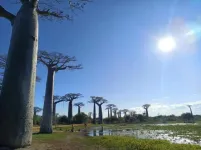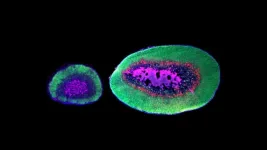(Press-News.org) The baobab (Adansonia) is a genus of trees with eight extant (in existence currently) species and a long history of humans marveling at them. For as much admiration the baobabs get, there is an equal amount of mystery surrounding their origin.
Genomic and ecological analyses recently done by a global research team led by Sino-Africa Joint Research Center, CAS (hosted by Wuhan Botanical Garden of the Chinese Academy of Sciences), suggest that Madagascar, is the origin from where all other baobab species hail. With a deeper understanding of the baobabs' genetics, researchers are hoping to uncover some clues on what can be done to aid in the conservation of these phenomenal trees under rapidly changing environments.
Researchers published their results in Nature on May 15.
Madagascar is known for its intriguing and unique flora and fauna, including the wondrous baobab tree. Their fascinating characteristics have led to the trees gaining the monikers "mother of the forest" and "tree of life." However, despite the cultural significance of the baobabs and their influence, not much is known about their evolutionary history.
Using high-quality genomic data from all eight extant baobab species, the evolutionary history of the baobab lineage has been uncovered and proposed. The data points to baobab origination in Madagascar with later dispersion to Africa and Australia; more specific factors such as climate, animal pollinators, and in particular, local sea level changes, have seemed to shape each species to its environment.
According to the genomic data regarding baobab lineage, the most likely scenario that is compatible with the exchange of genes throughout baobab species is that all baobabs originated in Madagascar. Of the eight species, six of those baobab species' range is limited to Madagascar.
"What we see about baobabs in Madagascar today was greatly influenced by both interspecific competition and the geological history of the island, especially changes in local sea levels," said Dr. WAN Junnan, first author and researcher from WBG.
Having a solid understanding of how sea level, and therefore climate change and subsequent habitat loss, affects the Malagasy baobab can give insight into how the other species of baobabs might fare when faced with similar issues. According to the global mean sea level (GMSL) over the past 10 million years, researchers extrapolated that baobab trees were more likely to disperse and expand when sea levels were lower. If this trend continues to hold up, rising sea levels from a changing climate could hinder the population expansion of baobabs, and already might have had an impact.
The lowered chance of expansion coupled with the distinct ecological niches baobabs occupy is a recipe for a threatened population. Then, adding in habitat loss of the trees themselves along with their pollinators like fruit bats and hawkmoths, and conservation of baobabs becomes a pressing issue.
Researchers have proposed the classification of some baobab species be reconsidered by the IUCN Red List of Threatened Species. This reclassification from endangered to critically endangered requires the cause of the decline to be known and a decline in population of at least 90%, which is the case for some species of baobab trees.
The work on the genetic data and history of baobab species is being done to preserve their presence in the ever-changing landscapes of the world. To move towards conservation and draw more attention to its distinctive characteristics, the researchers of this study aim to do more sampling of baobab trees to illuminate the evolutionary history of the Malagasy baobab. In addition to the work being done to clarify mysteries around the Malagasy baobab, other advances in learning about the diversity of flora found in Madagascar should follow suit.
The Scientific Research Program of Sino-Africa Joint Research Center and the National Natural Science Foundation of China made this research possible.
END
Unwrapping the origin story of the baobab
2024-05-15
ELSE PRESS RELEASES FROM THIS DATE:
The origin and long-distance travels of upside down trees
2024-05-15
The iconic baobabs, also known as upside-down trees, or the tree of life, have much cultural significance, inspiring innumerable arts, folklore, and traditions. A research published in Nature, involving international collaboration between Wuhan Botanical Garden (China), Royal Botanic Gardens (Kew, UK), University of Antananarivo (Madagascar) and Queen Mary University of London (UK) reveal a remarkable example of species radiation in Madagascar followed by long distance dispersal to Africa and Australia. With speciation, an astonishing divergence of pollination mechanisms evolved, that exploit hawkmoths, bats and lemurs for ...
Some mice may owe their monogamy to a newly evolved type of cell
2024-05-15
NEW YORK, NY — What makes the oldfield mouse steadfastly monogamous throughout its life while its closest rodent relatives are promiscuous? The answer may be a previously unknown hormone-generating cell, according to a new study published online today in Nature from scientists at Columbia's Zuckerman Institute.
"The hormone from these cells was actually first discovered in humans many decades ago, but nobody really knew what it did," said Andrés Bendesky, MD, PhD, a principal investigator at Columbia's Zuckerman Institute. "We’ve discovered ...
Mortality in patients hospitalized for COVID-19 vs influenza in fall-winter 2023-2024
2024-05-15
About The Study: This study found that in fall-winter 2023-2024, the risk of death in patients hospitalized for COVID-19 was greater than the risk of death in patients hospitalized for seasonal influenza.
Corresponding Author: To contact the corresponding author, Ziyad Al-Aly, M.D., email ziyad.alaly@va.gov.
To access the embargoed study: Visit our For The Media website at this link https://media.jamanetwork.com/
(doi:10.1001/jama.2024.7395)
Editor’s Note: Please see the article for additional information, including other authors, author contributions and affiliations, conflict of interest and financial disclosures, and funding and support.
# # ...
First ‘warm-blooded’ dinosaurs may have emerged 180 million years ago
2024-05-15
The ability to regulate body temperature, a trait all mammals and birds have today, may have evolved among some dinosaurs early in the Jurassic period about 180 million years ago, suggests a new study led by UCL and University of Vigo researchers.
In the early 20th century, dinosaurs were considered slow-moving, “cold-blooded” animals like modern-day reptiles, relying on heat from the sun to regulate their temperature. Newer discoveries indicate some dinosaur types were likely capable of generating their own body heat but when this adaptation occurred is unknown.
The new study, published in the journal Current Biology, looked at ...
Next-generation sustainable electronics are doped with air
2024-05-15
Semiconductors are the foundation of all modern electronics. Now, researchers at Linköping University, Sweden, have developed a new method where organic semiconductors can become more conductive with the help of air as a dopant. The study, published in the journal Nature, is a significant step towards future cheap and sustainable organic semiconductors.
“We believe this method could significantly influence the way we dope organic semiconductors. All components are affordable, easily accessible, and potentially environmentally friendly, which is a prerequisite for future sustainable ...
Disparities in patient portal engagement among patients with hypertension treated in primary care
2024-05-15
About The Study: This cohort study of patients with hypertension found clear sociodemographic disparities in patient portal engagement among those treated in primary care. Without special efforts to engage patients with portals, interventions that use patient portals to target hypertension may exacerbate disparities.
Corresponding Author: To contact the corresponding author, Rasha Khatib, Ph.D., M.H.S., email rasha.alkhatib@aah.org.
To access the embargoed study: Visit our For The Media website at this link https://media.jamanetwork.com/
(doi:10.1001/jamanetworkopen.2024.11649)
Editor’s Note: Please see ...
Dose-dependent association between body mass index and mental health and changes over time
2024-05-15
About The Study: This study revealed a U-shaped association between adolescent body mass index and mental health, which was consistent across sex and grades and became stronger over time. These insights emphasize the need for targeted interventions addressing body image and mental health, and call for further research into underlying mechanisms.
Corresponding Author: To contact the corresponding author, Shanquan Chen, Ph.D., email Shanquan.chen@lshtm.ac.uk.
To access the embargoed study: Visit our For The Media website at this link https://media.jamanetwork.com/
(10.1001/jamapsychiatry.2024.0921)
Editor’s ...
The doctor is in…. but what’s behind them?
2024-05-15
Americans have gotten used to seeing their doctors and other health care providers using telehealth video visits in the past four years. But a new study reveals that what a doctor has behind them during a telehealth visit can make a difference in how the patient feels about them and their care.
Even if the doctor is miles away from their usual in-person clinic or exam room, they should make it look like they’re there, the study suggests.
Even better: sitting in an office with their diplomas hanging ...
Structural evolution and high-temperature sensing performance of polymer-derived SiAlBCN ceramics
2024-05-15
The group of Gang Shao from Zhengzhou University, China recently investigated the structural evolution of pentagonal polymer-derived SiAlBCN ceramics (PDCs) and outlined PDC-based sensor technology for high-temperature extreme environments. The high-performance temperature sensing materials including high sensitivity, fast response, wide detection range are scarce and needful. This research developed a ceramic-based temperature with attractive performance that can be applied in high-temperature environments ...
An environmental CGE model of China’s economy: Modeling choices and application
2024-05-15
The general equilibrium framework of the CGE model widely used in cost-benefit analysis in the field of energy and environmental policy. Based on standard micro- and macroeconomic theories, the CGE model establishes quantitative connections between various sectors of the economy, enabling the examination of both direct and indirect effects resulting from exogenous changes in the economy, as well as their global impacts on the overall economy.
A team of energy economists by Yu Liu from Peking University in Beijing, China recently outlined the detailed content of their CGE model. This model is constructed based on the CGE model theory of the Australian Center ...






